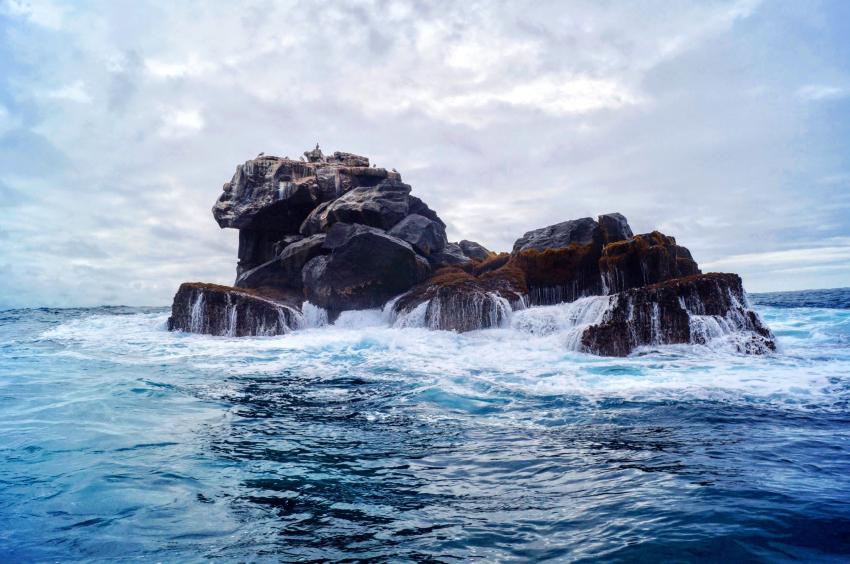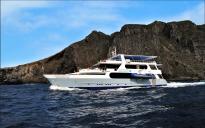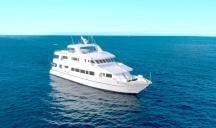LIVEABOARD DIVING IN Ecuador - Galapagos

10
liveaboards
Price from
USD 3,487 per trip
Ecuador's Galapagos Islands are a dream destination for scuba divers, known for their rich marine biodiversity and unique geological formations. Divers can expect to see a wide range of marine species, including hammerhead sharks, sea turtles, rays, and schools of colorful fish. The diving conditions can be challenging due to strong currents and colder water temperatures, so divers are recommended to have at least an advanced open water certification and experience with drift diving. One of the best ways to explore the islands is through liveaboard diving, which allows for extended diving times and access to more remote dive sites. In addition to diving, visitors can also explore the islands' fascinating wildlife and natural wonders, such as the iconic Galapagos tortoises and the volcanic landscapes
Destinations in Ecuador - Galapagos
When To Go Diving in Ecuador - Galapagos
The best time to go diving in the Galapagos Islands is during the dry season, from June to November. During this time, the water temperature is cooler, ranging from 18 to 24°C (65 to 75°F), which attracts a variety of marine life including large schools of fish, sharks, and whales. The warm season, from December to May, has water temperatures ranging from 20 to 28°C (68 to 82°F), which attracts different species of marine life such as manta rays, sea lions, and hammerhead sharks. Divers should bring a 5mm wetsuit, gloves, and a hood to protect against cool water temperatures during the dry season. During the warm season, a 3mm wetsuit may be suitable for some divers. Other important diving equipment items to bring include a dive computer, a signaling device, and a surface marker buoy. It's important to note that the Galapagos Islands are a unique and fragile ecosystem, and diving is highly regulated to protect the marine life and environment
Departure ports in Ecuador - Galapagos
There are three main departure ports for Galapagos liveaboard diving: Baltra Island, Puerto Ayora on Santa Cruz Island, and the Port of San Cristobal on San Cristobal Island. Baltra Island is located in the center of the Galapagos archipelago and serves as the main gateway for visitors to the islands. The nearest airport is Baltra Island (GPS). From the airport, visitors can take a bus to the Itabaca Channel, followed by a ferry to Santa Cruz Island. From there, they can take a taxi to Puerto Ayora. Puerto Ayora is located on the southern coast of Santa Cruz Island. Visitors can fly into Baltra Island and follow the above-mentioned route, or they can fly into the airport on Santa Cruz Island and take a taxi to Puerto Ayora.
The Port of San Cristobal is located on the eastern side of San Cristobal Island. Visitors can fly into the San Cristobal Airport (SCY) and take a taxi to the port. When it comes to airports, it's recommended that divers choose either Baltra Island or San Cristobal Island, depending on their chosen departure port. Most liveaboard diving tours depart from Puerto Ayora on Santa Cruz Island, so divers should fly into Baltra Island. However, some tours also depart from San Cristobal Island, so divers should fly into San Cristobal Island in this case. In summary, the departure ports for Galapagos liveaboard diving are Baltra Island, Puerto Ayora on Santa Cruz Island, and the Port of San Cristobal on San Cristobal Island. The best way to reach them is by flying into the respective airports and taking a taxi to the ports
Must see dive sites in Ecuador - Galapagos
Wolf Island, Cousins Rock, Darwin Island, Punta Carrion, and Gordon's Rock are some of the most well-known dive sites in the Galapagos Islands. Each of these sites offers unique diving experiences and opportunities to encounter diverse marine life. Wolf Island is famous for its shark encounters, including schools of hammerhead, Galapagos, and silky sharks. Divers may also spot manta rays, dolphins, and whales. The currents at Wolf Island can be strong, so it is recommended for experienced divers. Cousins Rock is a popular site for macro photography, with opportunities to see seahorses, nudibranchs, and frogfish. Divers may also see eagle rays, sea turtles, and schools of fish. The site is suitable for all levels of divers, with mild currents. Darwin Island is a bucket-list destination for many divers, known for its large schools of hammerhead sharks and occasional sightings of whale sharks and orcas. The currents at Darwin Island can be challenging, so it is recommended for experienced divers. Punta Carrion is a shallow dive site with mild currents, making it a great spot for beginners. Divers can expect to see sea turtles, rays, and schools of fish. Gordon's Rock is a popular site for encounters with Galapagos sharks, sea lions, and marine iguanas. The currents can be strong, so it is recommended for experienced divers. Overall, the diving conditions in the Galapagos can vary depending on the location and time of year. However, divers can expect to encounter a wide range of marine species, including sharks, rays, sea turtles, and schools of fish. Due to the unique nature of the islands, many dive sites require intermediate to advanced levels of experience due to the strong currents and sometimes challenging conditions
Frequently Asked Questions
Yes, it is possible to dive in the Galapagos Islands without a liveaboard. The Galapagos Islands have a variety of dive sites accessible from land-based operations on the islands of Santa Cruz, San Cristobal, and Isabela.
Liveaboard diving in the Galapagos Islands offers several benefits over land-based diving. Here are a few of the advantages of liveaboard diving in the Galapagos:
Access to remote dive sites: Many of the best dive sites in the Galapagos are located far from the populated islands and can only be reached by boat. Liveaboard diving allows you to access these remote sites and dive in areas that are less frequently visited by other divers.
More time to dive: With a liveaboard, you can maximize your time underwater since you'll be diving from the boat multiple times a day. This allows you to experience more dive sites and see more of the marine life that the Galapagos has to offer.
Flexibility: Liveaboards can be more flexible with their schedules, allowing you to choose when and where you want to dive. This can be particularly beneficial if you have specific dive sites that you want to visit or if you want to customize your diving itinerary.
Comfort and convenience: Liveaboards typically offer more comfortable accommodations and amenities than land-based operations. Plus, you won't have to worry about transportation to and from the dive sites since you'll be staying on the boat
First, you need to react to one of the main airports which are located in Quito and Guayaquil. These airports receive flights from major airlines, including American Airlines, Delta, United Airlines, and more. From North America and Europe, there are direct flights to Quito and Guayaquil from several cities, including New York, Miami, Madrid, Amsterdam, and more. You can also connect to Ecuador from other cities in South America. It's important to note that entry requirements for Ecuador may vary depending on your country of origin. In general, visitors are required to have a valid passport and may be required to obtain a visa or pay an entry fee upon arrival. Make sure to check the latest entry requirements before you travel. Once you arrive in Ecuador, you can travel to the Galapagos Islands by taking a domestic flight from Quito or Guayaquil to either the Baltra or San Cristobal airport in the Galapagos. From there, you can arrange for transportation to your liveaboard or land-based dive operator

